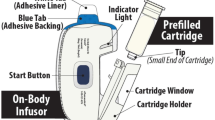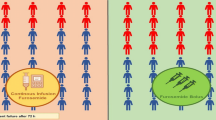Abstract
Introduction
The most common symptom in heart failure (HF) is congestion, which can be refractory to diuretic treatment.
Aim
To verify whether, in patients with advanced HF and diuretic resistance, subcutaneous furosemide or furosemide in an oral solution can improve the clinical-analytical status.
Methods
From 2018 to 2020, 27 consecutive outpatients with diuretic resistance, not candidates for other alternatives, were recruited. Patients were treated either with subcutaneous furosemide in elastomeric pump (n: 10) or with oral solution (n: 17) for 5 days.
Results
The functional status (NYHA) improved with subcutaneous administration (predose: 3.8 ± 0.5 vs. postdose: 3.1 ± 0.7; p: 0.02) and oral solution (predose: 3.7 ± 0.3 vs. postdose: 2.5 ± 0.7; p: 0.0001). Weight loss was greater with the oral solution (predose: 85.5 ± 19.5 vs. postdose: 81.3 ± 18.8Kg; p: 0.0001) than subcutaneous (predose: 81.6 ± 15.9 vs. postdose: 80.4 ± 15.1kg; p: 0.16). Creatinine showed a non-significant increase in both groups. The number of hospital visits showed no difference between both options.
Conclusions
The administration of furosemide, both subcutaneously by elastomeric pump or drinking the oral solution, is effective for the treatment of congestion in advanced HF refractory to diuretic treatment.

Similar content being viewed by others
References
Mcdonagh TA, Metra M, Adamo M, et al. ESC Guidelines for the diagnosis and treatment of acute and chronic heart failure. Eur Heart J. 2021;2021:1–128.
Fendler TJ, Swetz KM, Allen LA. Team-based palliative and end-of-life care for heart failure. Heart Fail Clin. 2015;11(3):479–98.
Valente MA, Voors AA, Damman K, et al. Diuretic response in acute heart failure: clinical characteristics and prognostic significance. Eur Heart J. 2014;35(19):1284–93.
Chiong JR, Cheung RJ. Loop diuretic therapy in heart failure: the need for solid evidence on a fluid issue. Clin Cardiol. 2010;33(6):345–52.
Fonzo-Christe C, Vukasovic C, Wasilewski-Rasca AF, et al. Subcutaneous administration of drugs in the elderly: survey of practice and systematic literature review. Palliat Med. 2005;19(3):208–19.
Yancy CW, Jessup M, Bozkurt B, et al. 2013 ACCF/AHA guideline for the management of heart failure: a report of the American College of Cardiology Foundation/American Heart Association Task Force on practice guidelines. Circulation. 2013;128(16):240–327.
Jaarsma T, Beattie JM, Ryder M, et al. Palliative care in heart failure: a position statement from the palliative care workshop of the Heart Failure Association of the European Society of Cardiology. Eur J Heart Fail. 2009;11:433–43.
Comín-Colet J, Manito N, Segovia-Cubero J, et al. Efficacy and safety of intermittent intravenous outpatient administration of levosimendan in patients with advanced heart failure: the LION-HEART multicentre randomised trial. Eur J Heart Fail. 2018;20(7):1128–36.
Seferovic PM, Ponikowski P, Anker SD, et al. Clinical practice update on heart failure 2019: pharmacotherapy, procedures, devices and patients management. An expert consensus meeting report of the Association of the European Society of Cardiology. Eur J Heart Fail. 2019;21(10):1169–86.
Yancy CW, Jessup M, Bozkurt B, et al. 2017 ACC/AHA/HFSA Focused Update of the 2013 ACCF/AHA Guideline for the Management of Heart Failure: a report of the American College of Cardiology/American Heart Association Task Force on Clinical Practice Guidelines and the Heart Failure Society of America. J Card Fail. 2017;23(8):628–51.
Zatarain-Nicolás E, López-Díaz J, de la Fuente-Galán L, et al. Tratamiento de la insuficiencia cardiaca descompensada con furosemida subcutánea mediante bombas elastoméricas: experiencia inicial. Rev Esp Cardiol. 2013;66(12):999–1005.
Mullens W, Damman K, Harjola VP, et al. The use of diuretics in heart failure with congestion-a position statement from the Heart Failure Association of the European Society of Cardiology. Eur J Heart Fail. 2019;21(2):137–55.
Griffin M, Soufer A, Goljo E, et al. Real world use of hypertonic saline in refractory acute decompensated heart failure: A.U.S. Center’s Experience. JACC Heart Fail. 2020;8(3):199–208.
Marra AM, Proietti M. Diuretic resistance in decompensated chronic heart failure: trying to get out of the loop. Intern Emerg Med. 2019;14(4):497–8.
Damman K, Testani JM. The kidney in heart failure: an update. Eur Heart J. 2015;36(23):1437–44.
Verma AK, da Silva JH, Kuhl DR. Diuretic effects of subcutaneous furosemide in human volunteers: a randomized pilot study. Ann Pharmacother. 2004;38(4):544–9.
del Prado DS, Sancho Zamora MA, Collazo S, et al. Perfusión de furosemida subcutánea como tratamiento paliativo en insuficiencia cardíaca refractaria. Rev Colomb Cardiol. 2020;27(1):44–8.
Romero Candela G, Tejada CF. ¿Qué inyectables pueden ser administrados por vía oral o enteral? Rev Clín Med Fam. 2015;8(2):119–24.
Beattie JM, Johnson MJ. Subcutaneous furosemide in advanced heart failure: has clinical practice run ahead of the evidence base? BMJ Support Palliat Care. 2012;2(1):5–6.
Kida K, Doi S, Suzuki N (2020) Palliative care in patients with advanced heart failure. Heart Fail Clin 16(2):243-54. https://doi.org/10.1016/j.hfc.2019.12.006
Takase H, Dohi Y. Kidney function crucially affects B-type natriuretic peptide (BNP), N-terminal proBNP and their relationship. Eur J Clin Invest. 2014;44(3):303–8.
Mullens W, Damman K, Testani JM, et al. Eur J Heart Fail. 2020;22:1–20.
Verbrugge FH, Steels P, Grieten L, et al. Hyponatremia in acute decompensated heart failure: depletion versus dilution. J Am Coll Cardiol. 2015;65:480–92.
Pose A, Almenar L, Manzano L, et al. Hyponatraemia and congestive heart failure refractory to diuretic treatment. Utility of tolvaptan. Rev Clin Esp. 2017;217(7):398–404.
Rodríguez-de Muñoz YM, Sánchez-Lázaro IJ, Almenar-Bonet L, et al. Use of tolvaptan in patients with hyponatremia due to heart failure: initial experience. Rev Esp Cardiol. 2013;66(4):319–21.
Pose A, Almenar L, Gavira JJ, et al. Benefit of tolvaptan in the management of hyponatraemia in patients with diuretic-refractory congestive heart failure: the SEMI-SEC project. ESC Heart Fail. 2017;4(2):130–7.
Zacharias H, Raw J, Nunn A, et al. Is there a role for subcutaneous furosemide in the community and hospice management of end-stage heart failure? Palliat Med. 2011;25(6):658–63.
Sancho-Zamora MA. Home subcutaneous infusion of furosemide in advanced decompensated heart failure. Rev Esp Cardiol. 2014;67(3):241–2.
Funding
This research received no Grant from any funding agency in the public, commercial or not-for-profit sectors.
Author information
Authors and Affiliations
Contributions
All persons listed as authors must have contributed substantially to the design, performance, analysis, or reporting of the work. RL-V: Designed research, Performed research, Collected datam Analyzed datam Wrote paper, Review of the manuscript. IS-L: Designed research, Performed research, Analyzed data, Review of the manuscript. IHT: Collected data, Analyzed data Review of the manuscript. EMB: Designed research, Wrote paper, Review of the manuscript. JNV: Designed research, Wrote paper, Review of the manuscript. VDT: Designed research, Collected data, Wrote paper, Review of the manuscript. LMD: Analyzed data, Wrote paper, Review of the manuscript. LAB: Designed research, Performed research, Collected datam Analyzed datam Wrote paper, Review of the manuscript.
Corresponding author
Ethics declarations
Conflict of Interest
On behalf of all authors, the corresponding author states that there is no conflict of interest.
Supplementary Information
Below is the link to the electronic supplementary material.
Rights and permissions
About this article
Cite this article
López-Vilella, R., Sánchez-Lázaro, I., Husillos Tamarit, I. et al. Administration of Subcutaneous Furosemide in Elastomeric Pump vs. Oral Solution for the Treatment of Diuretic Refractory Congestion. High Blood Press Cardiovasc Prev 28, 589–596 (2021). https://doi.org/10.1007/s40292-021-00476-4
Received:
Accepted:
Published:
Issue Date:
DOI: https://doi.org/10.1007/s40292-021-00476-4




